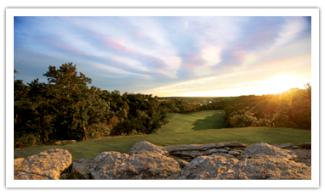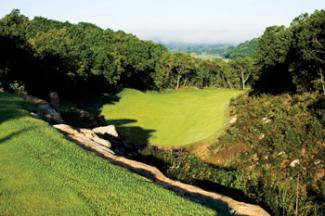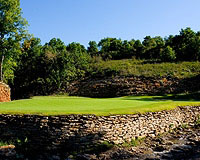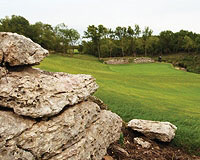Featured Golf News
Visual Feast & Great Design Herald Success at Patriot GC
The vision behind the design and building of the Patriot Golf Club in the near-northeast Tulsa suburb of Owasso was an ostentatious one: fashion a course like no other in Oklahoma on a difficult piece of ground without moving much earth.

You're on top of the world at the first tee at The Patriot
The cause the Patriot GC's owners and founders have adopted is even grander - to salute the United States' armed forces and benefit families of military members killed or disabled in service to their country.
Both the vision and cause are labors of love and, with the Patriot GC's grand opening on Memorial Day 2010, consider the latter accomplished. Designed by Robert Trent Jones II and constructed over a two-year period by Landscapes Unlimited, Patriot is stunning in its beauty and extremely challenging visually. But, thanks to Jones's handiwork, the track's bark is much worse than its bite.

The view from the 14th hole at The Patriot
The building of Patriot presented incredible challenges thanks to the need to traverse through four distinct and often hostile topographies: lowland marshes, heavy woodlands, high prairies and limestone canyons.
"Because of the rock, there had to be some earthmoving, but not much," Jones said. "Most of the Patriot is natural architecture. We could follow what nature gave us."
The rocky terrain required importing a 10-inch layer of sandy-loam top soil throughout its 80 sodded acres; irrigation lines to water the track were literally carved through limestone.
The result is a course with enormous Meyer Zoysia fairways and virtually no rough. Patriot needed extraordinary greens to be a really special course, so Jones and crew selected A1-A4 Bentgrass for the putting surfaces, which are protected from the stifling Oklahoma heat by a subterranean moisture-control system and turf-breeze fans.
Beach-white bunkers are set throughout the Patriot, providing a striking contrast against the lush green turf. Layers of limestone accent the grounds and naturally buffer sightlines between the course and neighboring homes.
By contemporary standards, the overall construction is truly minimalist and respectful of the land. Only about 200,000 yards of dirt were moved in the project, most of which came on only three holes, located on Patriot's lower prairie.
Golf for a Greater Cause
As to its honorable goal of respecting the families of killed or disabled military personnel, the Patriot is at the epicenter of the Folds of Honor Foundation, whose flag-flying headquarters is next door to the clubhouse.
The Folds of Honor Foundation was founded by Major Dan Rooney, a decorated F-16 fighter pilot in the Oklahoma Air National Guard who served three combat tours in Iraq. He is also one of the founders of the Patriot Golf Club.
Rooney, a PGA member from Stillwater, Okla. and a former University of Kansas golfer, also established Patriot Golf Day, a national golf fundraiser that is expected to attract more than 6 million golfers at 10,000 courses throughout the U.S. this Labor Day weekend. Each golfer will be asked to make a minimum $1 donation.
The Patriot will provide another revenue stream. The goal is to raise $1 million a year for Folds of Honor through a percentage of profits, initiation fees, guest fees and memberships. It's a private club, but limited "Patriot" rounds will give non-members a chance to play the course and support the foundation.
Rooney's dream was to develop a special place that transcends the game and forever serves as a legacy to American soldiers, proving how golf is more than just a great sport. He hit the sweet spot with Patriot.

The Green on Patriot's 6A
Up & Down the Hills in Oklahoma
The Patriot is the centerpiece of Stone Canyon, a residential community some 15 minutes northeast of Tulsa. The par-72, 7,158-yard course features two nine-hole loops that include a set of junior tees. From its back set of four tees, the Patriot carries a rating of 74.3 and a slope of 130.
Jones's team worked to find a way to incorporate all the different terrain changes into the course, in essence taking a player on a journey through all four of the topographies. It's rare that a single course has so many variations, and Rooney said it gives players a chance to sample all parts of Oklahoma in one round.
"As the holes move through different landscapes the course also seamlessly changes tempo and rhythm," Jones said. "It may yield pars to deep thinking, but golfers must get to know its intricacies, especially on and around the greens."
The ground game is an integral part of the Patriot, taking the player back to the Scottish origins of the game. But the ability to play the ball in the air - you will be able to count the hang time on your watch on a handful of shots thanks to huge drops from tee to fairway - is just as important.

Seventh Green at Patriot
Changes in elevation are extreme, so much so that some cart paths have multiple switchbacks. Longtime Tulsans who have played the course say they had no idea such a piece of land even existed in the area. "A lot of people have said they feel like they are in Colorado at times or up in the Ozarks," said David Bryan, the Patriot's director of golf.
That aspect starts on the first shot of the round where you tee off on the 566-yard par-5 opening hole from a perch some 140 feet above the landing area. From the tips, players can see the skyline of downtown Tulsa in the distance. "The first shot on the first tee is just a jaw-dropper," Bryan said.
The 494-yard par-4 third is Patriot's No. 1 handicap hole. It works uphill from right to left and plays along the base of a steep bluff through the lowlands of the course. Three well-placed greenside bunkers defend this tough, elevated approach shot.
The Patriot is actually a 19-hole golf course, with two sixth holes, both of which are par-3s. The 132-yard "6"A is set at the confluence of three canyons, with a peninsula green that allows for no margin of error. Its backdrop is a natural-rock face some 20 feet tall. No. "6B," playing at 119 yards, also offers a do-or-die scenario. Set within a dramatic rock canyon accompanied by a stream and waterfall, this hole's small green makes proper club selection vital.
The eighth is a massive 499-yard par-4 from the tips and takes the player out of the canyons and into the woodlands. A wide fairway allows players to choose their angles of attack; the right side provides a shorter approach but must challenge the paralleling stream, while the left provides more room for error but yields a longer approach. The wide eighth green is surrounded by bunkers making up-and-downs difficult.
The front side ends with a 240-yard one-shotter that plays slightly downhill. Protecting bunkers and a small ravine flank the back and right sides of the green and should be avoided at all costs. The best way to find the surface is to utilize the funneling slope in the fairway.
The back-nine at the Patriot offers a cool 3-3-3 routing and begins with the course's longest hole, the 603-yard 10th. Set in an open grass field, it's the first hole to traverse the high plains. Offset bunkers force players to calculate angle, distance and trajectory and tightly mown areas around the green are a real challenge.
No. 14 has a spectacular 120-foot drop from the tee box to a canyon-carved fairway chute. The 474-yard par-4 moves hard left to right and the second shot is played into an open-entrance green hanging over the banks of a stream situated left and long.
Nos. 15 and 16 are back-to-back par-5s that share a well-bunkered fairway through an open meadow. At 567 yards, the 15th is a 90-degree dogleg-left, featuring a stream at the bend that later crosses short of the green. This putting surface is perched at the base of a large wooded hillside and is guarded by two bunkers right. On the 559-yard No. 16, a sliver of fairway impinged by cross bunkering off the tee yields the best angle into the green. The elevated target once again accepts a variety of approaches from bump-and-run to pitches to lobs.
Even after all you've seen in your round, the 430-yard par-4 finisher might be the most visually intoxicating hole at Patriot. It's a dogleg-left that hugs a canyon; the green occupies a ridge some 90 yards across the steep chasm, serving as a fitting conclusion to a thrilling round of golf.
"Jones says the key to a good design is to have a good first hole and a good last hole," Bryan said. "We have accomplished that for sure. The beauty of it is we have got so many other good holes and very scenic holes. Most courses have one signature hole, and I feel like we happen to have about six."
"There is no doubt that the 18th is an epic finish," Rooney said. "But its drama may be eclipsed by the walk off the green knowing that your round was part of a much bigger cause."
The course was intended to be a living museum and a call to patriotism. Each hole was named in honor of a famous patriot. No. 1, for instance, is George Washington; No. 18 is Dwight David Eisenhower.
"The site was a natural treasure," Jones said. "We're glad to add a new paradigm to Oklahoma golf." The Patriot GC is that and more, and should be mentioned quickly among the short list of great courses built in the 21st century.
For more information, visit http://www.patriotgolfclub.com.
Steve Habel is one of Cybergolf's national correspondents, contributing news stories, features, equipment and book reviews and personality profiles from his base in Central Texas. He is also the managing editor for Texas CEO Magazine and works as a contributing editor for Horns Illustrated magazine, a publication focusing on University of Texas sports. He also writes a blog (www.shotoverthegreen.blogspot.com), which features news on golf and the Longhorns, and another (www.checkinginandplayingthrough.blogspot.com) on his many travels, which took him across the nation and to 105 different golf course in 2009. Habel is a member of the Golf Writers Association of America and the Texas Golf Writers Association.
Story Options
 |
Print this Story |
